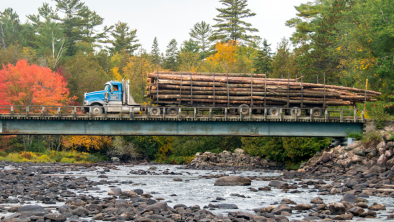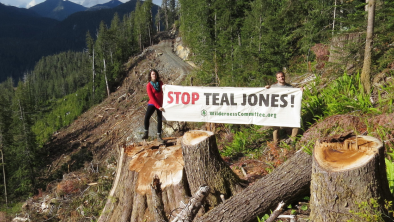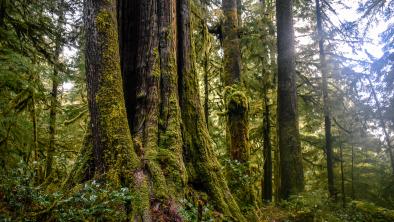BC's Timber Future Focus of Traveling MLAs
Monday, June 18, 2012
TheTyee.ca

As a committee of MLAs starts a whirlwind tour of British Columbia to consult on timber supply, members say the challenges are large and they're trying not to raise expectations.
This week the legislature's Special Committee on Timber Supply will hold public hearings in two communities a day, starting with Smithers and Houston Monday. By the end of the week it will have been to Burns Lake, Fraser Lake, Fort St. James, Vanderhoof, Prince George, Mackenzie, Valemount and McBride.
In each community there will be a half-hour roundtable with community leaders, an hour meeting with First Nations and a three-hour public hearing.
"It's not going to be easy," said John Rustad, the MLA for Nechako Lakes and the committee chair. "There's no way to please everybody with this."
"These are very quick visits. The time constraints are real," said Norm Macdonald, the committee's deputy chair and the NDP's forestry critic. "I think we were clear we had questions from the beginning about the process... The government has set things up the way they've set it up."
Committee members from both sides of the House -- it includes four BC Liberal and three NDP MLAs -- are doing the best they can given the constraints, he said. The questions the committee is putting forward to communities suggest there's going to be much more work to be done, rather than creating the expectation they'll find all the solutions, he said.
The committee will continue its work in the first two weeks of July with hearings in 100 Mile House, Williams Lake, Quesnel, Prince George (again), Merritt and Kamloops, plus three days in Vancouver. The public can also send written, video or audio submissions to the committee until July 20.
By Aug. 15, the committee's required to have its report written and submitted to the legislature.
'No magic bullets,' says chair
"There are no magic bullets to this," said Rustad.
Even if the committee's recommendations are "extremely aggressive" and the government acts on them, it won't be enough to fully mitigate the reduction in timber from the mountain pine beetle epidemic, he said. Instead it's a matter of trying to minimize the effects, he said.
The public got a taste in April of what the government's considering from cabinet documents about finding enough timber to justify rebuilding the Babine Forest Products sawmill in Burns Lake, which burned down after a January explosion.
The leaked document proposed various ways to free up more timber for milling, including logging at an unsustainable rate, cutting down more old growth and wildlife habitat, removing trees that were left to protect views, and allowing cabinet to make decisions instead of the chief forester.
Premier Christy Clark confirmed those options were on the table and said there needed to be a public discussion. An official from the United Steelworkers said the union representing many forest sector workers supports the government's direction, along with better long-term management of the resource.
Observers quickly pointed out that whatever's done in Burns Lake, there'll be pressure to do the same in forestry-dependent communities across the province.
Considering options
A discussion paper the committee released last week outlined the problem faced as beetle-killed pine becomes unsalvageable. "It is projected that 10 to 15 years from now, overall provincial timber supplies will be 20 per cent below the pre-infestation levels and that this reduction may last for up to 50 years," it said.
In areas where there's more pine, the drop in harvest level will be even larger, it said. "Decreases in timber supply will have significant negative economic and social impacts on communities."
It lists options, including lifting constraints as cabinet was considering, "increasing the harvest of marginally economic timber," allowing trees to be harvested sooner, and managing forests more intensively.
The questions the paper outlines for the public hearings are general, such as "What values and principles should guide the evaluation and decision-making regarding potential actions to mitigate the timber supply impacts?"
It asks who should make the decisions and how, as well as how individuals and communities should be engaged on these issues in the future.
During the committee's hearings, Rustad mentioned he'd had a presentation from six First Nations suggesting logging in Tweedsmuir Provincial Park to make up the shortfall.
It's a measure Forests, Lands and Natural Resources Minister Steve Thomson ruled out and one which the NDP's Macdonald said: "I just think that's not on."
Rustad, for his part, said, "I don't think we could go there," but added that it's important everyone's point of view is heard. "It's worthy of having a discussion."
Climate change ignored: MLA Simpson
The reaction to the committee will vary in each community, said Bob Simpson, the independent MLA for Cariboo North and a former forestry company executive. In Burns Lake there'll be interest in rebuilding the mill, while other communities will have concerns about opening longstanding land use plans to seek new sources of timber.
Since the committee was struck, Simpson has said it should be looking at ways to help communities make transitions, rather than simply looking for more saw logs to delay the inevitable shift by a few years.
He noted it's strange the committee's meetings so far have ignored the impact climate change is likely to have on the province's forests. "All the climate modelling says our biogeoclimatic zones are shifting north rapidly," he said.
That means there'll likely be greater impact from fires, pests and disease in the future, he said. The government has heard advice in recent years that it should compensate for climate change by reducing the annual allowable cut and increasing the amount of forested area in the province, but so far that's not been part of the discussion, he said.
"It's a huge gap in the mitigation they're looking at," he said. The models the government is using and that the committee is looking at are all based on past growth and yield, and they no longer fit, he said.
Adding to the unknowns, Macdonald noted the Auditor General, the Forest Practices Board and professional foresters have all questioned the accuracy of the government's inventory data.
The committee's work is unlikely to result in a radical change to forest management, he said. "The management structure we have presently is there for a reason," he said. "There are multiple values that are obviously considered. The reasons for considering them haven't changed."
He said there is knowledge and wisdom to be gained listening to people in the affected communities, but there are no easy solutions. "I think in the end this committee is going to be part of an ongoing process of how we manage the change that has happened and will happen going forward," he said.
Rustad said that while much of the information the committee has to consider is technical, it's seeking guidance from people on what they see as the priorities. "In some areas we'll hear forestry is central," he said. "In other areas we'll hear forestry is one component of what we do."
He acknowledged the committee is likely to hear perspectives ranging from people wanting to protect more forest from logging to those wanting to log in provincial parks, and said it will be a challenge to judge and weigh those priorities.


